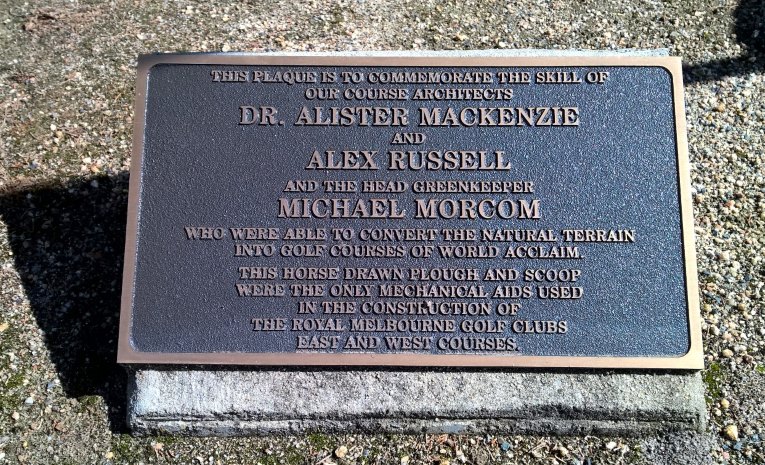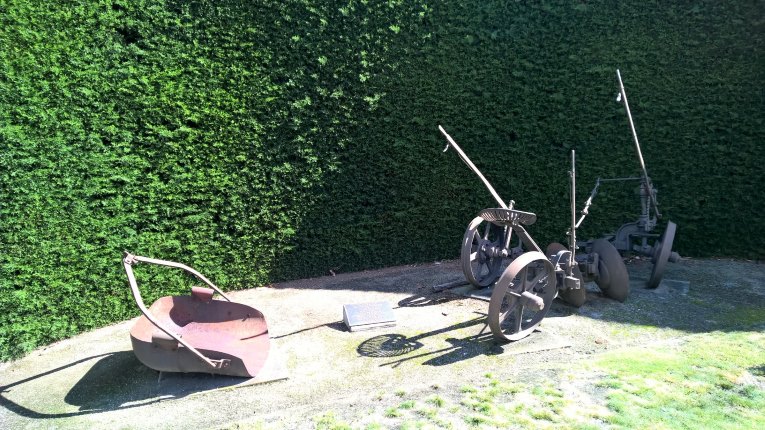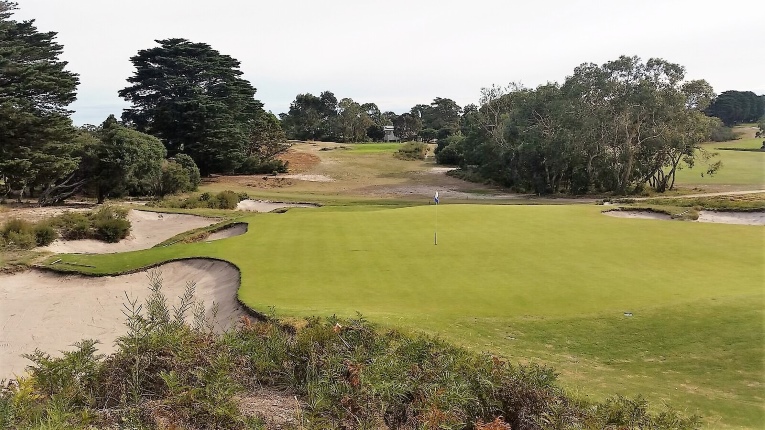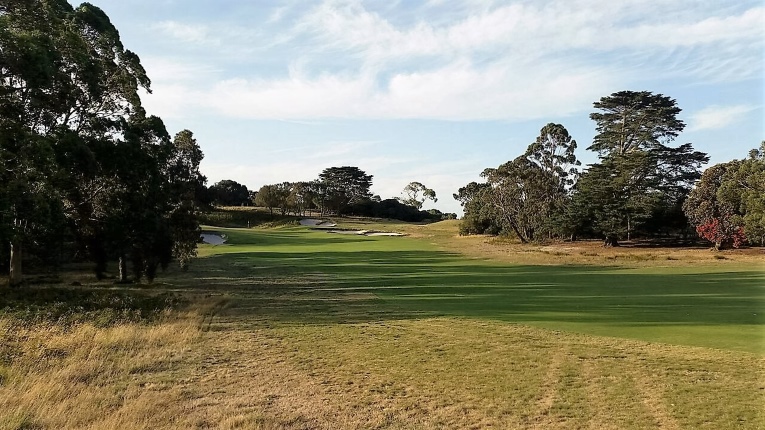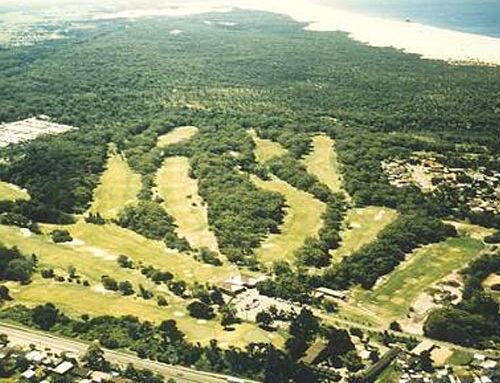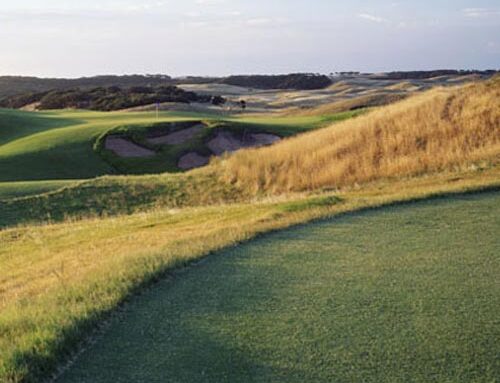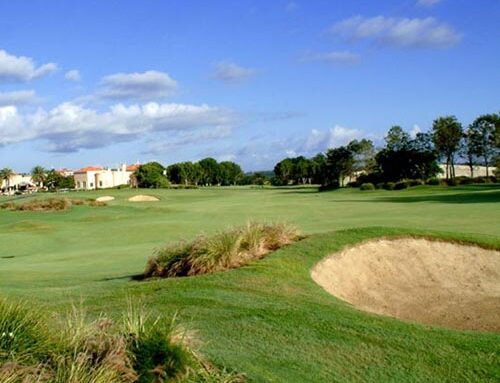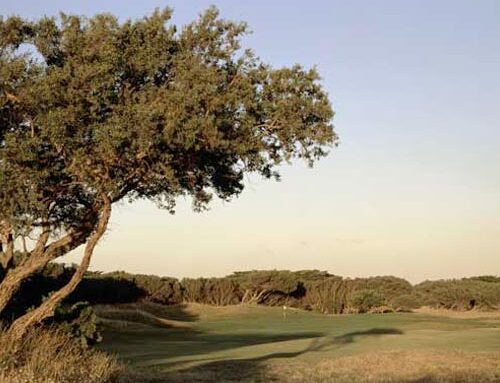Royal Melbourne Golf Club (West Course)
Victoria, Australia
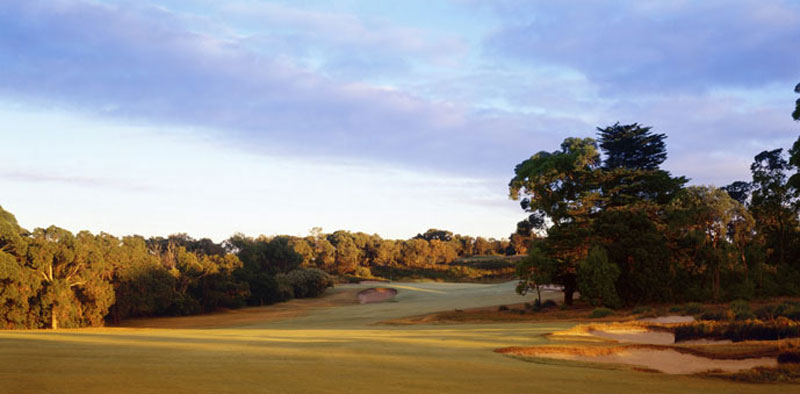
Royal Melbourne West is a tactical masterpiece with its sixth hole being a prime example.
Think of golf in the northern half of the world and visions of St. Andrews, Cypress Point, Sand Hills, Royal County Down or Pine Valley might dance through your head. Think of the golf in the southern hemisphere, and one course stands out above all others: The West Course at Royal Melbourne. This Alister MacKenzie creation carries the mantle for a vast part of the world – and has done so with great aplomb since the “good doctor” journeyed there in 1926.
MacKenzie’s sole visit to Australia was only a two month stint (he left on January 1st, 1927) but he covered tremendous ground and visited all five of Australia’s great cities (Adelaide, Brisbane, Melbourne, Perth, and Sydney). Melbourne is where his impact was the greatest, in part because of the famed ‘Sandbelt,’ a perfect canvas for MacKenzie’s vision of ideal golf. At Royal Melbourne, he was granted an expansive swath of land, the middle of which featured dramatic movement. Additionally, he benefited from his two primary contacts: Alex Russell (past Australian Open champion and keen student of architecture) and Green Keeper Mick Morcom (who subsequently ascended into the pantheon of green keepers alongside Joe Valentine from Merion and Emil Loeffler from Oakmont).

Six years after MacKenzie left, Russell and Morcom fashioned elaborate bunkers of alarming excellence on the East Course.
What MacKenzie – evidently – instilled in these gentlemen was the concept of strategic golf. At the time of his visit the Golden Age of Design was well and truly under way … elsewhere. Australia of the mid 1920s lacked golf of sufficient sophistication to compare with the world’s elite. MacKenzie transformed the region when he routed the course and imparted the design tenets that would ‘test the best while being fun for the rest.’
Behind much of MacKenzie’s philosophy loomed The Old Course at St. Andrews, where Mackenzie consulted for the Royal & Ancient. No need to wonder where the concept of wide fairways and large greens stemmed (!) but those two ingredients were the underpinning for his design. What distinguishes the West Course from other courses that share those attributes is the construction and placement of its hazards and how they tie in with the elaborate putting surfaces ahead.
To gain the optimal advantage off the tee, the better golfer must confront the hole’s primary defenses. At the second hole if the fairway bunker on this five par is successfully carried, the stronger golfer is rewarded with a second shot into a large, angled green. Similar to The Old Course, being on the green is only the beginning. Given the contours, firmness, and pace of these famed putting surfaces, three putts – and worse – abound for those out of position relative to the day’s hole location. The better golfer is continually challenged to play with care and precision; the less accomplished player can bumble along and enjoy his stroll without trepidation of losing his ball.
In the case of the West Course, MacKenzie’s design beliefs come to life in technicolor because of the elegance of his well-placed hazards. This course and especially the hazards adhere so closely to nature as to make most other courses look sterile. Give Morcom credit for the standard that he created until his retirement in 1935. The most famous inland courses – Pine Valley, Merion, Sand Hills – are made so by the nature of their hazards with Royal Melbourne’s being second to none. According to Tom Doak (who is now the consulting architect for the club), ‘The bunkers at RM are real hazards – a big part of which is they use the fine native sandy loam which is harder to play from than the sissified perfect bunker sand specified by American green committees. You do not hear anyone hoping their ball will “get in the bunker” at RM and MacKenzie would be pleased at that.’

Situated across undistinguished land, look at the handsome visuals and playing interest created by the sprawling bunkers at the 220 yard sixteenth hole.
Brian Slawnik is Doak’s Lead Associate for Royal Melbourne. He has spent many weeks on site, which has afforded him the opportunity to determine for himself what makes these hazards so special. He explains, ‘From a shaper’s perspective, it is fun to figure out where they generated the material to build features. The compositions are so broad and the tie-ins so flawless it can be difficult to tell. Take a look at the photograph of the sixteenth hole above. Note how far left and right the bunkers extend before fading from view. Russell and Morcom had a wonderful knack for making hazards that were big without being loud. Those hard bunker edges that you see above are works of art and are possible because of the Couch thatch. A fescue course wouldn’t hold the same edge but here in the Sandbelt where the sand is so soily and compacts, they had a unique opportunity to build very special hazards. And, of course, that’s exactly what they did though I’m told it was Crockford who added many of the fingers and capes to the bunkers to stabilize the sand.’
As you drive into the club, you pass along a hedgerow where a scoop and horse drawn plough are proudly displayed beside the plaque below:
No wonder the bunkers appear so natural! Man’s hand was especially ‘soft’ on the land. Heavy machines never obliterated or altered the landscape here, not that there was a need: the property’s movement and soil composition was exquisite. As man started working on less and less desirable sites in the 1960s-1980s, more and more earth was moved in an ill-gotten attempt to lend playing interest. Such courses pale in comparison to the real deal found at Royal Melbourne.
Slawnik points to other benefits from the use of such equipment. First, there was no expectation for speed. Therefore, the workers were given time to see develop whatever it was that they were working on. Tweaks could occur in a slow, measured manner. Additionally, since what amounts to teaspoons of dirt were being moved, nothing rash or untoward could happen to the landscape. Slawnik appreciates this forced economy of movement and the value derived from shapers being compelled to be judicious in their actions.
Upon Morcom’s retirement, another titan of green keeping took over, Claude Crockford, and he carried on the tradition for the next four (!) decades. His rise to the top of the profession was based in part on the fabulous glassy, frictionless putting surfaces that he eventually obtained. Golf took a back seat to world events for the first half of Crockford’s reign but by the 1960s and 1970s, Royal Melbourne was synonymous with great greens. MacKenzie’s grandest design principles had now been realized in spades, albeit thirty to forty years after his visit. The author likens it to the grassing of the Pinehurst No. 2 greens in the mid-1930s; yes, the course already enjoyed great fanfare but when the greens were optimized, the course was elevated to the best of that architect’s work. By the time Crockford retired in the 1970s, the Melbourne greens – which were never ‘green’ but far more ominous in their molten colorings – had become the gold standard world-wide.
The following Holes to Note section is unique for this web site. While every single hole is worthy of detailed analysis, only holes that could reasonably make a list of the finest eighteen holes in the world are discussed. At its core a great golf course must have great holes. This ultimately is the attribute that lifts Royal Melbourne (West) above the other courses in the Sandbelt and places it among the world’s handful of greats. Only National Golf Links of America and Pine Valley could lay claim to a similar number of all-universe holes.
Holes to Note
Third hole, 355 yards; Laid over only moderately interesting land, the hole shines because of its green complex, reminding the author of both Pinehurst No. 2 and Winged Foot West where the targets (i.e. the greens) transform mundane properties into world class venues. After a drive or three wood, the golfer is left with a shortish iron to a relatively big green. So what’s the big deal? The fairway falls slowly to a green that continues to slope away, requiring the approach to land on the front third of the green lest the ball end up at the back, or over. Should the approach pull up just shy of the green, it collects in the fronting swale, leaving the player a chip several feet up a bank to a green that slides away. Greens like this readily identify well-executed approaches while poor ones readily turn two strokes into three. This gem befuddled the world’s best during the 1998 President’s Cup where some tried to drive it only to be left in a dead zone some 20-40 yards short with a nervy chip. St. Andrews features a plethora of greens with front to back slopes and to understand the full reach of her importance, look no farther than this green complex 10,000 miles away.
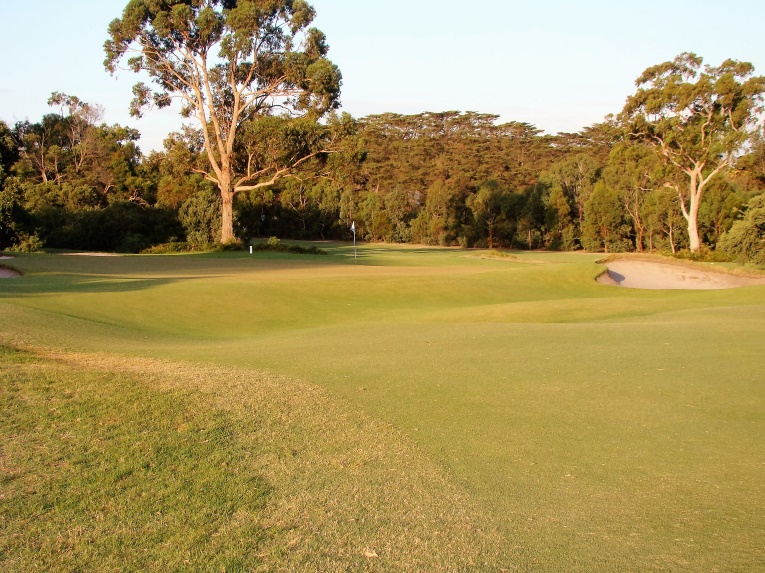
Innocuous, at first glance, the approach to the fallaway third green is a real fooler that insists that the ball be well struck.
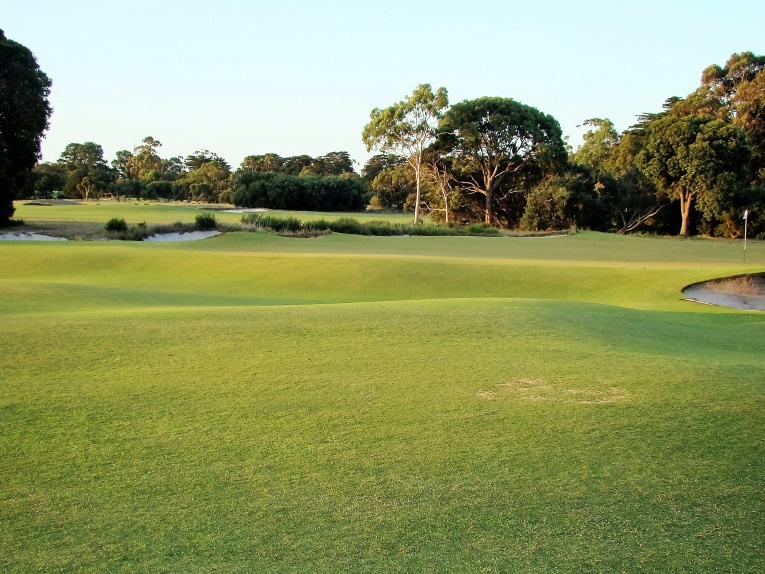
As seen from the side, a positively gorgeous diagonal trough fronts the putting surface that slopes toward the rear.
Fourth hole, 500 yards; Alister MacKenzie built the three “gold standard” half par holes in the world: the sixteenth at Cypress Point, the thirteenth at Augusta National and the fourth here. Interestingly, the thirteenth at Augusta and this hole have similar bends, albeit in opposite directions. A good drive at both opens up a range of enticing possibilities. Here, a strong tee ball that carries the crest gains an extra ~ 25 yards of roll and brings the green into reach. What an approach shot it is: certainly among a handful of the most thrilling in Australia. To the right of the green extending thirty yards into the fairway is what has been described as ‘the country’s greatest bunker’ – fifteen feet deep with a variety of native shrubs and vegetation to keep a lonely golfer company. The genius here was in the routing and incorporating the hillock perfectly to challenge and reward the tee shot. Sublimeness results from the elegant design and placement of both the fairway and green side bunkers.

An approach from 200 meters that skirts past the scruffy wasteland is one that’s imprinted on the golfer forever.

Approach shots that fail to reach the putting surface are often shunted right into this famous bunker.
Fifth hole, 175 yards; One of golf’s finest green sites nestles into its own lovely amphitheater and is framed by native Australian bush and deep bunkers that eat into the putting surface. MacKenzie surely had the Eden hole at St. Andrews in mind when he oversaw the construction of this green complex with its severe back to front tilt. This is surely the finest one shotter in a city known for its superlative short holes and stands alone for another reason: it is the only hole that MacKenzie saw completed during his 54 day stay in Australia.
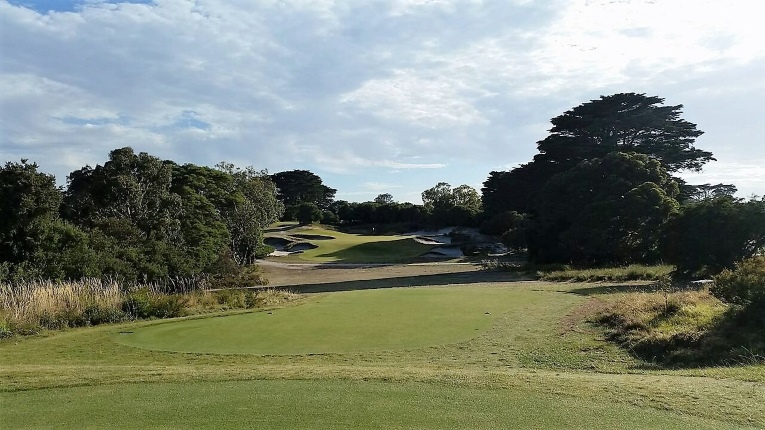
There is no official accounting of how the routing process unfolded but one imagines that this natural beauty was a quick find by MacKenzie.

As seen from the side, the fierce back to front cant replicates the terrors of putting on the Eden green at St. Andrews.
Sixth hole, 430 yards; Too many doglegs are made so by trees which dully force the golfer to hit straight ahead. Not here where playing angles abound and two golfers of the same skill level might approach the green with as much as a three club difference, depending on their aggression off the tee. The closer the golfer hugs the inside, handsomely adorned with scrub and sand, the easier his approach shot. If the golfer steers his tee ball away from the fairway bunkers, the more his approach must confront the deep left greenside bunker. Additionally, the putting surface is one of the game’s marvels, with more horror stories of four putts and worse told here than any other surface in the Sandbelt. Most famously, Sam Snead, after driving to the outside of the dogleg and finding the back right of the green, putted into the front left greenside bunker. One can only imagine the colorful narrative that Snead put on that story! Certainly, he found out the hard way that be it the eleventh at Pasatiempo or the ninth at Augusta National, an uphill MacKenzie green must be approached with maximum care. Selected by Pat Ward-Thomas in The World Atlas of Golf as the greatest sixth hole in the world, there is no reason to argue and most consider this the quintessential dogleg because of the perfect balance achieved between risk and reward. The commanding position of the elevated sixth tee is for many people – literally and figuratively – the pinnacle of Australian golf.
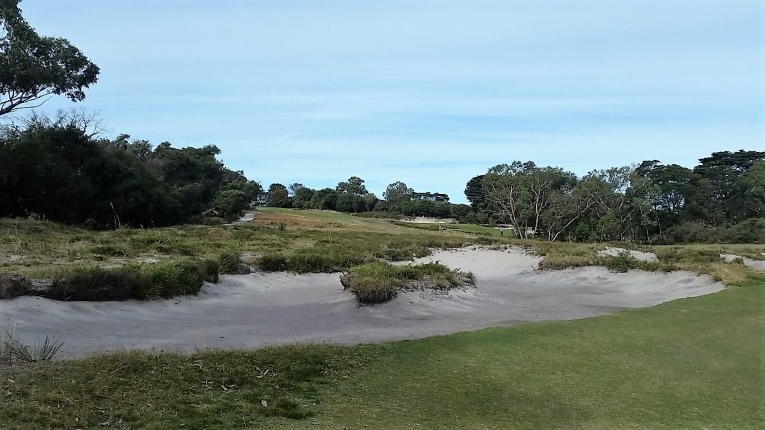
Looking back toward the tee, the unkempt rustic nature of the inside of the dogleg would greatly please MacKenzie as the hazards emerge organically from nature. Where nature ends and man’s hand begins is indistinguishable.
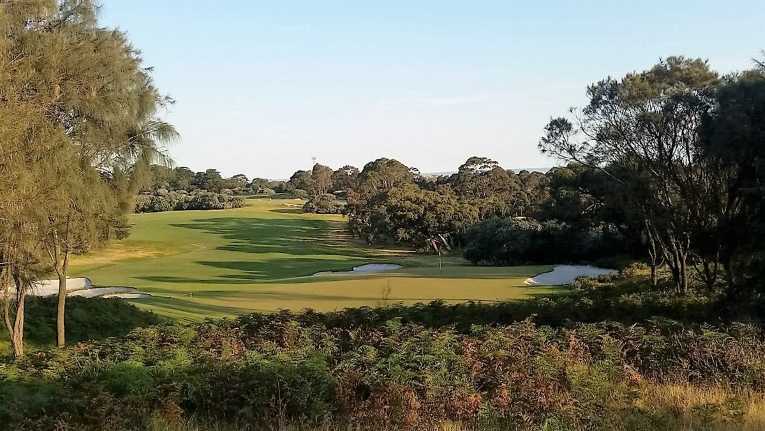
As seen from behind, Royal Melbourne excels at keeping the playing corridors wide (preserving the intended playing angles) while still utilizing the Australian bush to handsomely frame holes.
Seventh hole, 150 yards; This uphill one shotter rivals the superb, more often photographed 15th at Kingston Heath for playing merit. Yet, MacKenzie doesn’t deserve credit. Rather, Claude Crockford does. Peter Thomson details in the 1976 World Atlas of Golf how Crockford, under the guidance of Ivo Whitton (the club’s best player), moved MacKenzie’s green location to a slightly lower spot: ‘Crockford’s 150 yard 7th is a rare gem of planning and construction. To stand by it during a championship is endless entertainment because scores from the best players vary in quick succession from two to five or even seven. It was built on a sandy hill by horse and scoop like the rest of the course. It slopes in an intriguing line from back to front although there is adequate flat, or nearly flat, territory for the flagstick in one or two spots – a deception not always discovered until it is too late by players in awe of its glassy surface. It is surrounded by traps of good depth and formidable sides, with a foreground like a miniature natural park of small indigenous flora to add to its rugged appearance.’ Yes indeed, staying beneath the flag is one of the two or three most important challenges of the round and the hole (both its aesthetics and shot requirement) fits seamlessly with the rest. Generally, work by a green keeper following the advice of a club’s best player to override a MacKenzie (!) design would stick out like a sore thumb – but not here. In contrast to a certain famous MacKenzie design in Georgia, great work has been performed internally at MacKenzie’s two finest designs in Australia (Royal Melbourne and Kingston Heath). The game continues to flourishes in Australia in part because the strong heritage of green keeping is passed along from one generation to the next.

The right front bunker is a trap in another, more sinister way as it encourages the golfer to go long left from where there is no prospect for an immediate recovery. Given that the putting surface is the high point of its immediate surrounds, accurately judging the greens back left to front right sweep is shockingly difficult.
Tenth hole, 315 yards; A drivable short two shotter where anything is possible. The decision is made at the tee: does the golfer challenge the pit bunker in the crook of the dogleg and attempt to draw the ball onto the green? If so, a score of eagle to double-bogey awaits. Or does he aim straight ahead, leave a tidy pitch, and reduce the likely outcome to birdie, par or bogey? Mike Clayton considers it the finest hole of its length in the world. Clayton recalls, ‘I watched Severiano Ballesteros play 10 West in the 1978 Australian PGA. Nobody ever went for the green but every day he flew at it with his driver, hitting 4 great drives up into the sandy waste just short. He made 3 birdies, a fitting reward for brilliant and bold play. MacKenzie presumably never envisaged the shot but I think he’d have been delighted that his hole perfectly showed off the player capable of extraordinary flair. MacKenzie didn’t know it but he was designing courses for Ballesteros who embraced MacKenzie’s ideas of how golf should be played. Ballesteros was, of course, the only player to win at Augusta National, Royal Melbourne and The Old Course. Few holes better highlight the talents of both men than the tenth at Royal Melbourne.’
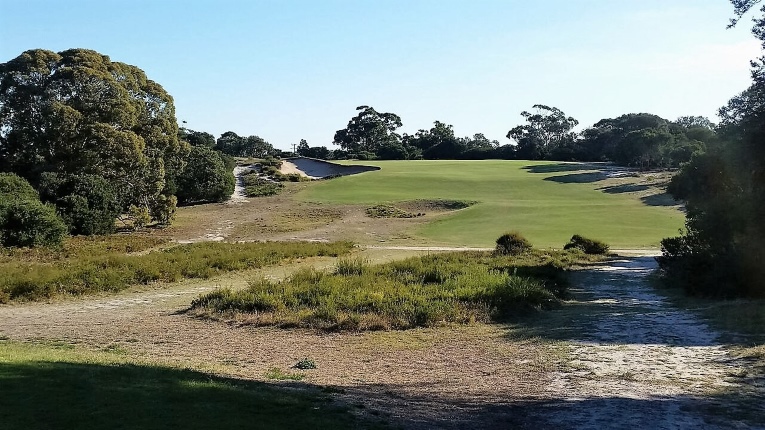
A brilliantly routed hole, the deepest bunker on the course was expertly positioned directly between the tee and flag creating all sorts of heroic notions and tragic peril for the golfer.
Seventeenth hole, 440 yards; This hole encapsulates many of MacKenzie’s most cherished design tenets. Look at how the hole plays for two classes of golfers. The less accomplished player does not mind that his tee ball gets shunted to the right by the cant of the land because his next target is likely short and left of the green where there is an ocean of short grass for a short pitch to save par. The tiger dearly wants to hug the inside of the fairway as it elbows left and obviate the right greenside bunker on his approach. Again, the exploitation of the lay of the land and the integration of strategic hazards creates something wonderful, yet natural.
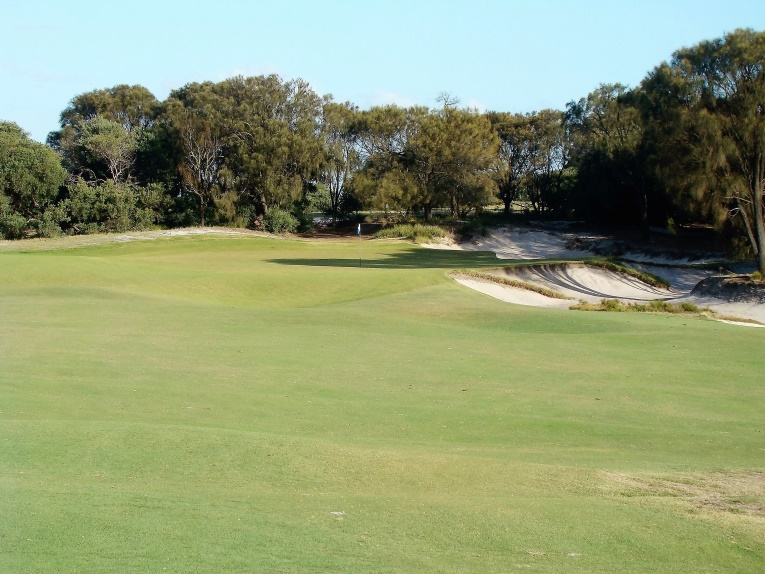
The bunkers are only on one side of the green and when big events roll into town, you can count on finding hole locations near the false front and along the right.
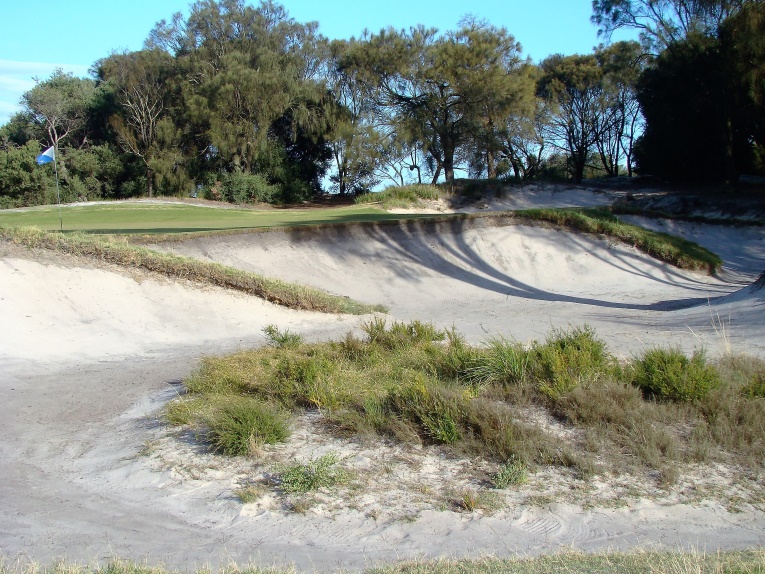
The good player will make the necessary adjustment so that his approach shot won’t drift right off the left to right fairway slope.
Eighteenth hole, 435 yards; While Royal Melbourne shares an abundance of design stratagems with The Old Course, in one aspect it surely does not: the dogleg. If you look at the holes singled out in this section, the majority of the non-one shotters dogleg. St. Andrews features only two, the seventh and seventeenth. MacKenzie perfected the art of the dogleg at Royal Melbourne; only his other masterpiece at Cypress Point comes close in its number of alarmingly excellent doglegs. While conceived in the age of hickory golf, the West Course has for the most part kept pace with technology. Having said that, dogleg holes are especially vulnerable to increased carry. In the late 1990s the author witnessed Greg Norman’s mere pitch into this green. No doubt it’s done with greater frequency now, which is a pity. Fortunately, the course is located less than a mile from Port Phillip and routinely enjoys the hidden element of wind as a defense. When the breeze is up, Royal Melbourne is at her best, technology be damned.

The wildly appealing tee ball at the Home hole, where every golfer is free to select his own line over the hazards on this dogleg right.
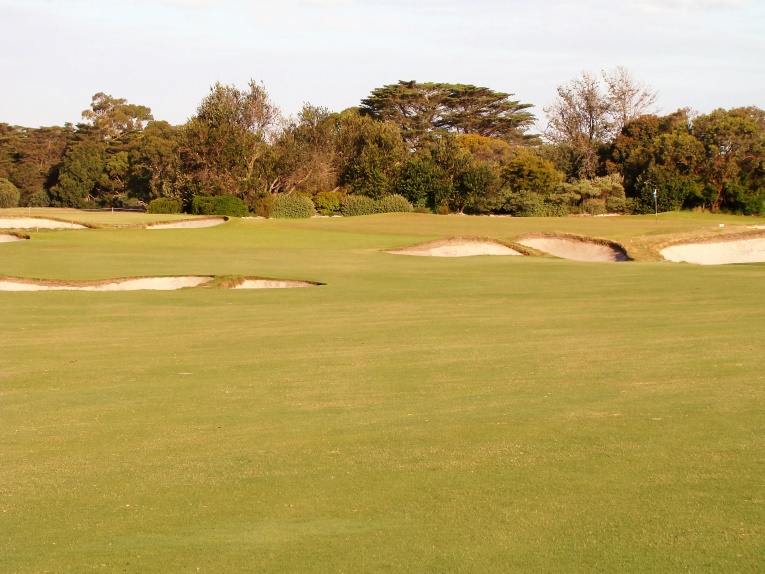
When played into a easterly, the approach still requires a long iron – and MacKenzie’s inventive bunkering pattern shines as it fans out from the green. Slawnik particularly admires how these bunkers were dug down below the native ground (as opposed to puffed up in the air as is the wont of some architects) and the gentle slopes that emanate from them. This construction technique lies at the heart of why the hole (and course) rests so peacefully on the land.
Speaking of length, MacKenzie’s routing (and in particular the short green to tee distances) was so efficient that adding significant length isn’t an option here. The last two holes are prime examples where the golfer virtually walks off the penultimate green and onto the tee for the Home hole. No possibility exists to lengthen 18 and other tees back up to the border of the property. So, the club wisely decided to combat distance in its own way. Doak comments: ‘Today’s grassing scheme at RM is actually borrowed from our St Andrews Beach project – bent greens, fescue approaches and surrounds for short game interest, and couch (Bermuda) fairways. The club was afraid the couch grass used by other clubs would make the course play too short and give too much roll on downhill landing areas like the 4th, 6th, 9th, and 11th on the West, so they chose a variety called Legend where the ball would NOT run out so much. It’s their way of fighting technology since there is precious little acreage for any additional back tees.’ The great William Flynn commented in the late 1920s about the need to slow down the run of tee balls as otherwise, the variety of approach shots would dwindle. Royal Melbourne has responded.
Sometimes when discussing ‘Royal Melbourne,’ confusion arises about because it isn’t clear which course is being discussed. The West Course houses the preponderance of world class holes among RM’s thirty-six but when international events are contested, a Composite Course is formed. The sequence of holes that constitute the Composite Course has changed over the years but the best version concludes with the seventeenth and eighteenth holes of the East Course. Nonetheless, the author doesn’t consider it sporting to rank the Composite Course; the West on its own needs no help. Slawnik concurs, noting of all the MacKenzie courses which he has seen, ‘Royal Melbourne comes as close to perfection as any.’
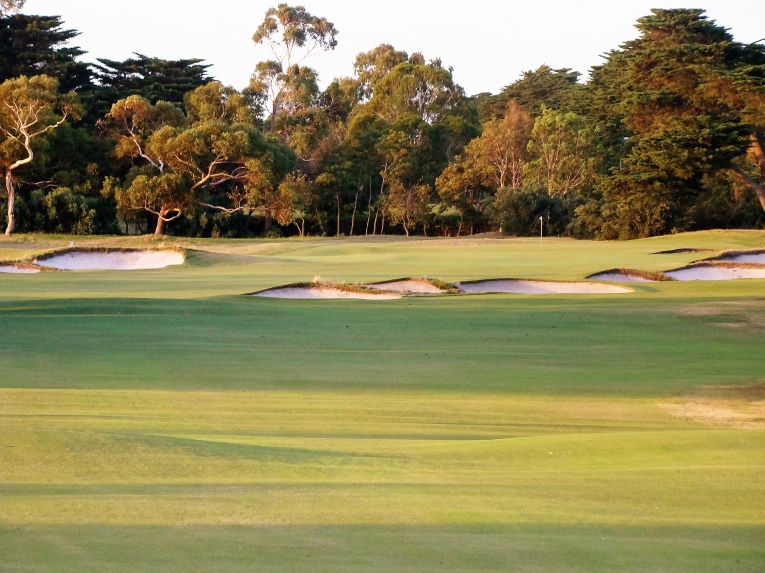
The sole hole of importance missing from the West is a true three shotter. The 610 yard seventeenth on the East solves that shortcoming when the Composite Course is created. More so than length, the hole is famous for its echelon bunkers that extend well out from the green.
Alister MacKenzie’s book of work has no peer. Three of his courses (Cypress Point, Augusta National and here) are routinely judged to be among the world top ten and end any meaningful debate of ‘world’s greatest architect.’ For the author, today’s overplanted, tinkered version of Augusta National is well-removed from any conversation about MacKenzie’s design philosophies. To best appreciate MacKenzie’s greatness as an architect, it boils down to a study between Cypress Point and Royal Melbourne. For the author, the unparalled firm playing surfaces at Royal Melbourne give it the slight edge and make the West Course a core requirement for every serious student of golf architecture. All effort should be expended from any point on the globe to come study what amounts to design perfection.
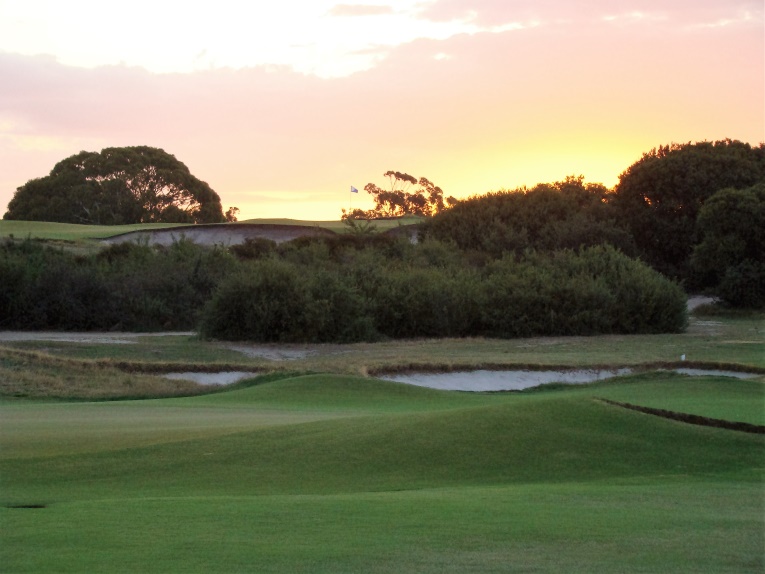
The sun never sets at supreme Royal Melbourne; looking across the rolls off the bunkers by the Home green and up to the seventh flag.
The author gratefully acknowledges the use of David Scaletti’s lead photograph and other photographs from Matthew Mollica and Ben Jarvis.
The End


